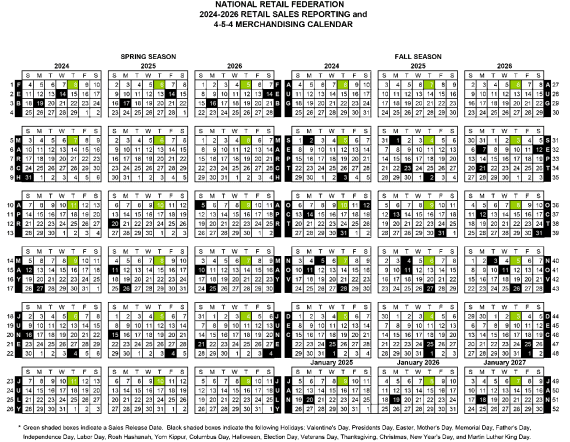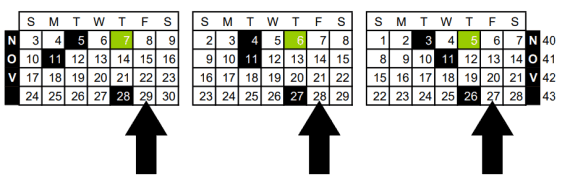Since the 1930s, retailers have used the 4-5-4 fiscal calendar to streamline and improve forecasting. This somewhat peculiar planning method could help modern retailers and direct-to-consumer brands.
Ending the year on the same weekday simplifies comparisons across timeframes, aiding in strategic decision-making.
Here’s how.
4-5-4 Calendar
The 4-5-4 retail calendar is a scheduling framework that divides the year into months of four weeks, five weeks, and four weeks in a repeated pattern, ensuring each fiscal month starts and ends on the same weekday. This design aligns sales data across similar periods.
In the United States, the National Retail Federation maintains a 4-5-4 retail calendar for its members.


The NRF’s 4-5-4 retail calendar for 2024-to-2026 divides the year into consistent three-month quarters, wherein the months have four, five, and four weeks, respectively. Click image to enlarge.
4-5-4 Advantages
The 4-5-4 calendar structures the fiscal year into consistent, comparable periods.
The ability to compare date ranges — particularly weeks — facilitates smoother planning and estimates of consumer demand.
I spent nearly 10 years as the director of marketing and ecommerce for an omnichannel retailer. We depended on a 4-5-4 calendar so heavily that I was surprised recently when the respected owner of an ecommerce business told me he’d never heard of it.
Planning. For purchasing and marketing departments, the 4-5-4 calendar is a roadmap through retail’s inherent highs and lows.
The calendar recognizes the predictable swings in consumer shopping, optimizing, if you will, for those critical high-traffic windows, such as major holidays and seasonal shifts.
Imagine planning for the Christmas shopping season, which includes Black Friday. On the Gregorian calendar, Black Friday shifts between November 23 and 29, depending on the year.
This variability makes it challenging to accurately compare year-over-year sales for November because the number of post-Black Friday shopping days in that month can differ.
Enter the 4-5-4 calendar, which groups weeks into a consistent pattern, wherein each fiscal month starts and ends on the same day of the week every year. With this setup, Black Friday falls in the last week of November with exactly one shopping day afterward. In the Gregorian calendar, the number of shopping days after Black Friday varies from one to three.


With the 4-5-4 calendar, Black Friday occurs in the last week of November and is followed by exactly one shopping day that month, simplifying annual performance comparisons. Image: NRF.
This 4-5-4 consistency allows for direct, apples-to-apples comparisons of the critical holiday shopping period from one year to the next. Merchants can accurately measure the impact of Black Friday promotions and the subsequent shopping days until the end of November without the distortions caused by Thanksgiving Day’s floating date. Easter presents similar challenges.
Procurement and marketing teams can forecast demand, plan inventory, and set marketing strategies more precisely.
Analysis. Adopting the 4-5-4 calendar introduces a level of standardization that is helpful for the analytical rigor required in retailing and ecommerce.
This standardization simplifies conducting quarter-over-quarter and year-over-year analyses in most cases. However, there is a snag. Since a year is a bit longer than 52 weeks, the 4-5-4 calendar has a “leap year” where a 53rd week is added. Thus, the comparison fails every five or six years. Nonetheless, it’s far more standardized than the Gregorian alternative.
Bottom line, merchants can compare performance metrics such as sales, website traffic, and inventory turnover without the shifting number of shopping days.
4-5-4 Challenges
The 4-5-4 calendar presents challenges in training, technology, and financial responsibilities.
- Training and education. The 4-5-4 system requires training — explaining what it is, how it works, and how to use it. Accounting folks will likely pick it up quicker than marketers.
- Technological integration. Transitioning to a 4-5-4 fiscal calendar may require substantial adjustments to retail management software, analytics tools, and back-office systems — although the shift is an opportunity to audit current technologies.
- Financial responsibilities. A 4-5-4 methodology can affect obligations that align with the Gregorian calendar, such as tax reporting and compliance. Businesses must plan how their fiscal reporting will interface with tax and other requirements, possibly necessitating adjustments to accounting practices or additional reconciliation steps. Tax professionals experienced with non-standard fiscal periods can provide crucial insights.
Best Option?
Budgetary tools such as the 4-5-4 retail calendar have been around for years. If planning and comparisons pose no challenge for your business, focus elsewhere. Otherwise, switching the calendar might be just what you need.





